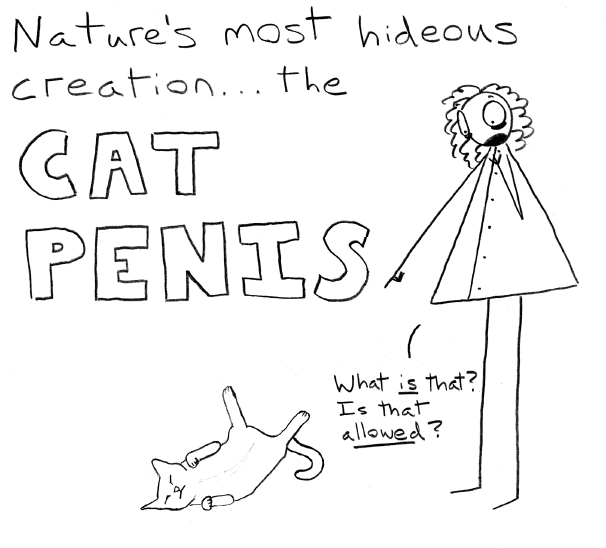Tomorrow will be our 3rd surgery test.

Hahahaha
*********************************************************
Phimosis
Phimosis is the stenosis of the preputial orifice prevents extension of the penis. The defect is likely to be a sequela to an injury that results in cicatrix (scarring) formation, but may be rarely congenital. Tumor such as melanoma or squamous cell carcinoma) or Habronema granulomas may encroach on the preputial cavity, thereby preventing extension.

Penis cannot be extruded from the prepuce

Congenital phimosis in a cat
Usually, the problem is unnoticed until the dog attempts to mate and is unable to copulate. Diagnosis is established by physical examination of the prepuce and penis. Treatment depends on severity of the stenosis and intended use of the dog. If the dog is not used for breeding, therapy probably is not needed, although castration should be considered to prevent arousal. Surgical enlargement of the preputial orifice is indicated if the animal is to be used for breeding, if the phimosis contributes to balanoposthitis, or in the unlikely event that phimosis interferes with normal micturition.
What to Watch For
- Unsuccessful attempts to copulate
- Inability to urinate with pooling of urine in the preputial cavity
- Dribbling urine
- Excessive licking of an exteriorized penis
- Necrosis/trauma of the penis and obstruction of urine flow
Clinical signs and ddx
Acute posthitis (inflammation of penis) often accompanies injuries to the prepuce of infections such as equine coital exanthema and dourine. Edema is common particularly after trauma. Gravitational effects typically worsen the edema which may include prolapse of the external prepuce, trapping the penis in the swollen internal prepuce with a constricting preputial ring. Cicatrix scar formation may follow narrowing the diameter of the preputial orifice.
Treatment
Preputial edema can be relieved by diuretics and exercise.Application of crushed ice in plastic bag or preputial immersion in cold water may reduce inflammatory edema if performed soon after injury. Systemic antibitotics and NSAID are indicated to control 2nd bacterial infection and inflammation. Sexual rest is indicated until lesions are healed.
Preputiotomy may be necessary to enlarged the opening sufficiently to permit penile extension. In cases of habronemiasis, treatment with insecticide or ivermectin may be indicated to kill remaining parasitic larvae. Congenital abnormalies can seldom be corrected surgically.
Paraphimosis
The inability to completely retract the penis into the preputial cavity usually occurs after erection. It is seen most often after semen collection or coitus. The skin at the preputial orifice becomes inverted, trapping the extruded penis and impairing venous drainage. Other causes of paraphimosis include mild phimosis, foreign objects around the penis, a constricting band of hair at the preputial orifice, or trauma. Paraphimosis is easily differentiated from priapism, congenitally shortened prepuce, congenital deformity of the os penis, or paralysis of the retractor penis muscles on the basis of physical examination and palpation.

Paraphimosis
Clinical signs and ddx
Penile paralysis in horses due to exhausted or debilitated horses. Traumatic inflammatory edema often results in severe swelling or preputial membranes that prevents retraction of penis into the prepuce.
Treatment
Requires immediate treatment. Sedation is sometimes required to provide therapy. The penis is examined and any restricting hairs are removed. Swelling is minimized with cool water soaks and or "dextrose" solutions. The penis is cleaned and lubricated and replaced in the prepuce. The goal is replacement of the penis to normal position. We can apply lubricant and push it back into the prepuce. A urinary catheter may be necessary to ensure the passage of urine.Amputation may be required in certain cases.
Sources: Merks veterinary manual 10th ed, paraphimosis and phimosis petplace.com, Infertility caused b diseases of the penis and prepuce, large animal internal medicine, Bradford Smith



















